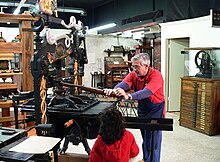Columbian press

The Columbian press was invented by George E. Clymer, probably in 1813, inspired in some measure by the earlier Stanhope press. It was designed to allow a whole newspaper page to be printed in a single pull. The press worked by a lever system, similar to that of the Stanhope press and quite different from the toggle action of the slightler later English Albion press. Clymer's new iron press was first advertised in April 1814. It went on to be manufactured in great numbers for over a century, chiefly in the United Kingdom but also in other European countries (a few were manufactured in America, but no surviving examples are recorded). It is sometimes, incorrectly, referred to as the 'Eagle' press due to the characteristic bald eagle counterweight which usually sits on the top lever. Some Columbians have the counterweight in another form (a simple ornament, a lamp, urn, or orb).

Bibliography
- Moran, James (1969). "The Columbian press". Journal of the Printing Historical Society (5): 1–23, plates 1–17.
- Oldham, Robert (2014). "The Columbian press at 200: a preliminary report on a world-wide census". Journal of the Printing Historical Society (N.S. 21): 51–66.
{{cite journal}}:|issue=has extra text (help)
External links
- Columbian Printing Press in the Collection of the Smithsonian Institution
- Columbian Printing Press in the collection of the Museum of New Zealand Te Papa Tongarewa
- Printing Yesterday and Today
- International Printing Museum Web site

